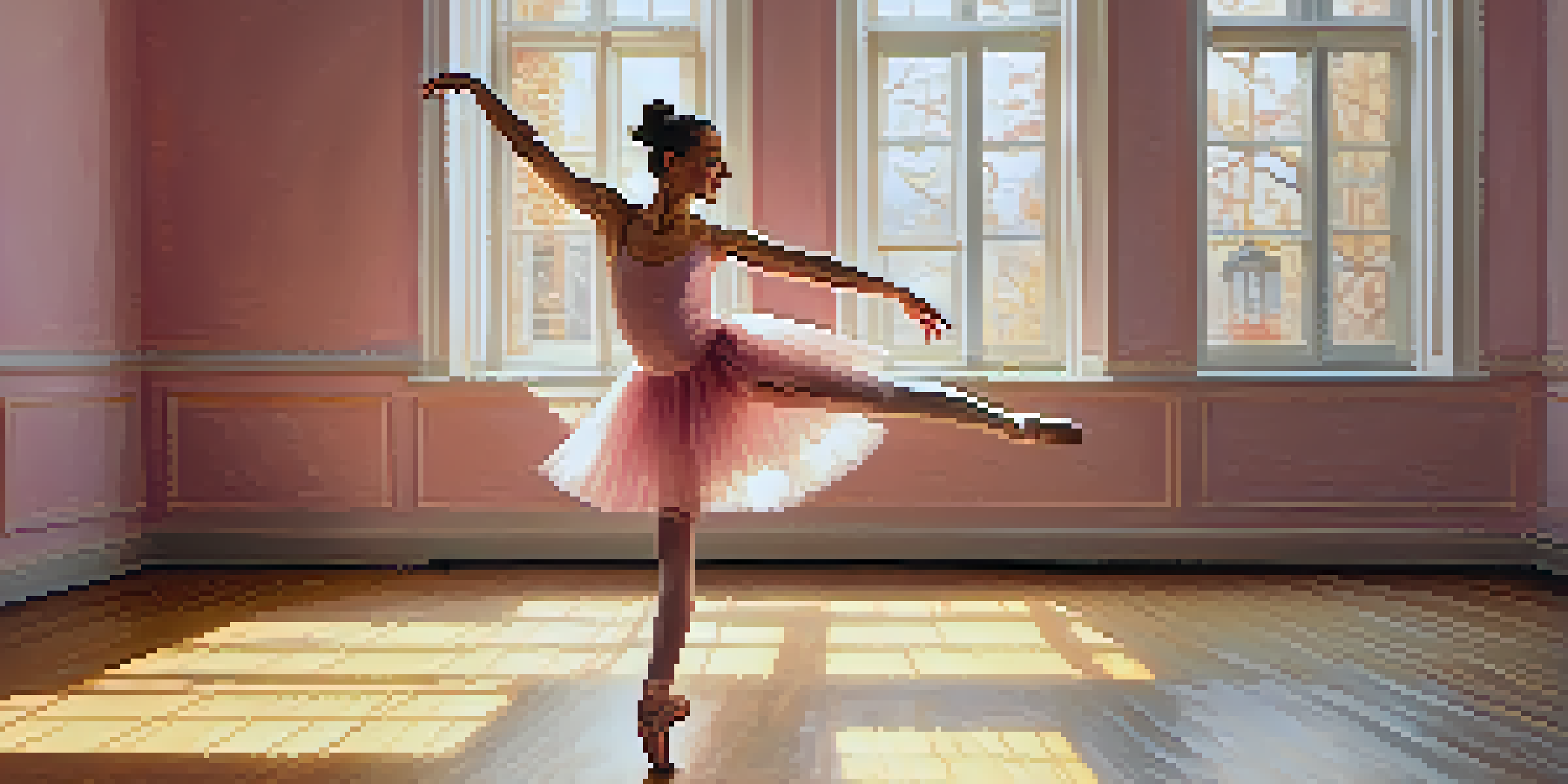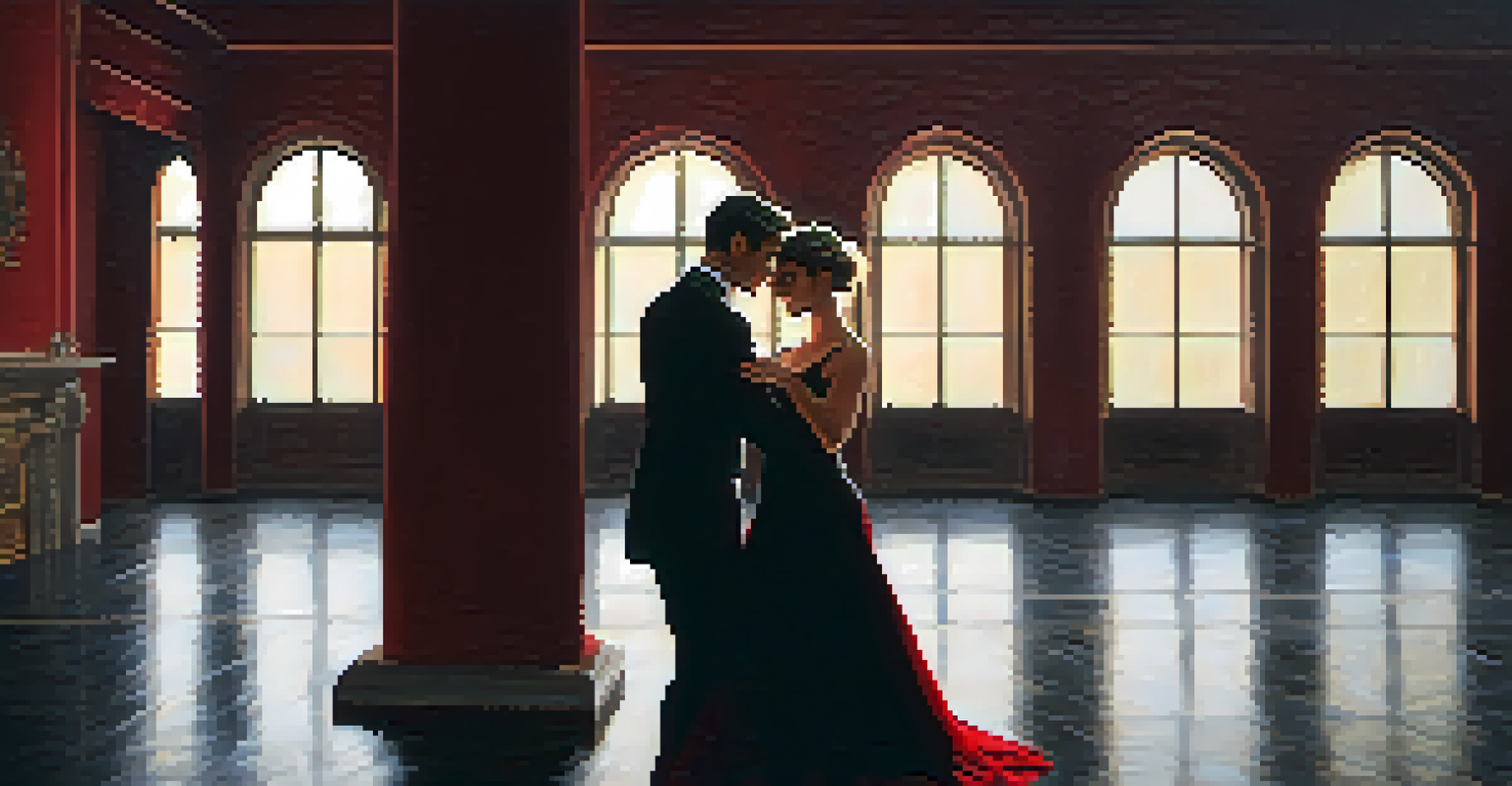The Role of Dance in Character Development in Movies

Dance as a Reflection of Character Emotion
Dance often serves as a powerful medium to express a character's inner feelings. Through movement, an actor can convey emotions that words might fail to capture, allowing audiences to connect more deeply with the character's journey.
Dance is the hidden language of the soul.
For instance, a joyful dance scene can highlight a character's happiness or newfound freedom, while a somber dance can illustrate their struggles and vulnerabilities. This emotional connection can make the character's journey more relatable and compelling.
By incorporating dance, filmmakers provide a visual language that enhances the narrative, allowing viewers to experience character emotions on a visceral level.
Establishing Character Relationships Through Dance
Dance sequences can beautifully illustrate the dynamics between characters, showcasing their relationships in a unique way. Whether it's a romantic duet or a competitive dance-off, these moments can speak volumes about the characters' connections.

Take the iconic dance in 'Dirty Dancing' as an example; it not only portrays the blossoming romance between the leads but also highlights their growth and trust in each other. The shared experience of dance becomes a metaphor for their evolving relationship.
Dance Reflects Character Emotion
Dance serves as a powerful medium to express a character's inner feelings, allowing audiences to connect deeply with their journeys.
Through choreography, filmmakers can encapsulate the essence of character interactions, making relationships feel more authentic and engaging for the audience.
Dance as a Tool for Character Transformation
In many films, dance acts as a catalyst for character growth and transformation. Characters can undergo significant changes during dance sequences, symbolizing their journey from conflict to resolution.
Through dance, I can express things that I can’t put into words.
For example, in 'Billy Elliot,' the protagonist's passion for ballet helps him break free from societal expectations and embrace his true self. The dance sequences serve as pivotal moments that reflect his internal struggle and eventual triumph.
By showcasing these transformations through dance, filmmakers can create memorable arcs that resonate with viewers long after the credits roll.
Cultural Context and Character Identity in Dance
Dance often embodies cultural heritage, allowing characters to express their identities and backgrounds. This cultural context adds depth to the character, making their experiences more relatable to audiences from diverse backgrounds.
In films like 'Coco,' the dance sequences are deeply rooted in Mexican culture, enriching the narrative and providing insight into the characters' traditions and values. This cultural representation fosters a greater understanding and appreciation for the characters' journeys.
Dance Enhances Character Relationships
Dance sequences illustrate the dynamics between characters, showcasing their relationships through movement and choreography.
By incorporating dance that reflects a character's cultural identity, filmmakers can create a richer, more immersive story that resonates with viewers from all walks of life.
The Role of Dance in Storytelling and Plot Development
Dance can serve as a vital storytelling device, moving the plot forward and deepening the audience's understanding of the narrative. In many cases, a dance sequence can encapsulate key plot points, making complex storylines more accessible.
For instance, in 'West Side Story,' the choreography not only entertains but also advances the story and reveals character motivations. The dance numbers become integral to the overall narrative, seamlessly blending entertainment with storytelling.
By weaving dance into the fabric of the plot, filmmakers enhance the storytelling experience, making it more dynamic and engaging.
Symbolism of Dance in Character Development
Dance often carries symbolic meanings that can enrich character development. Specific movements or styles can represent a character's personality traits, struggles, or aspirations, adding layers to their portrayal.
For instance, a character who dances with abandon may symbolize freedom and joy, while a more rigid style might reflect their internal conflicts or fears. These symbols allow viewers to gain insight into the character's psyche.
Dance Signals Character Transformation
Dance acts as a catalyst for character growth, symbolizing significant changes and internal struggles throughout the narrative.
By using dance as a symbolic tool, filmmakers can deepen the audience's understanding of the characters, making their journeys more impactful.
Dance as a Unifying Force in Ensemble Casts
In films with ensemble casts, dance can serve as a unifying force, bringing together diverse characters and highlighting their collective experiences. Group dance scenes often foster a sense of community and shared purpose among the characters.
Consider 'La La Land,' where the dance sequences not only showcase the individual talents of the characters but also emphasize their interconnected stories and dreams. These moments create a sense of belonging and shared aspiration.

By incorporating ensemble dance scenes, filmmakers can create a more inclusive narrative that resonates with the audience, showcasing the importance of collaboration and unity.
The Lasting Impact of Dance on Audience Perception
Dance has a unique ability to leave a lasting impression on audiences, influencing how they perceive characters and their journeys. Memorable dance sequences often become iconic, solidifying their place in cinematic history.
For example, the dance in 'Footloose' has become synonymous with the film itself, influencing how viewers remember the characters and their struggles. These moments can evoke nostalgia and emotional responses long after the film ends.
By crafting impactful dance sequences, filmmakers can ensure that the characters and their stories remain etched in the audience's minds, enhancing the overall viewing experience.